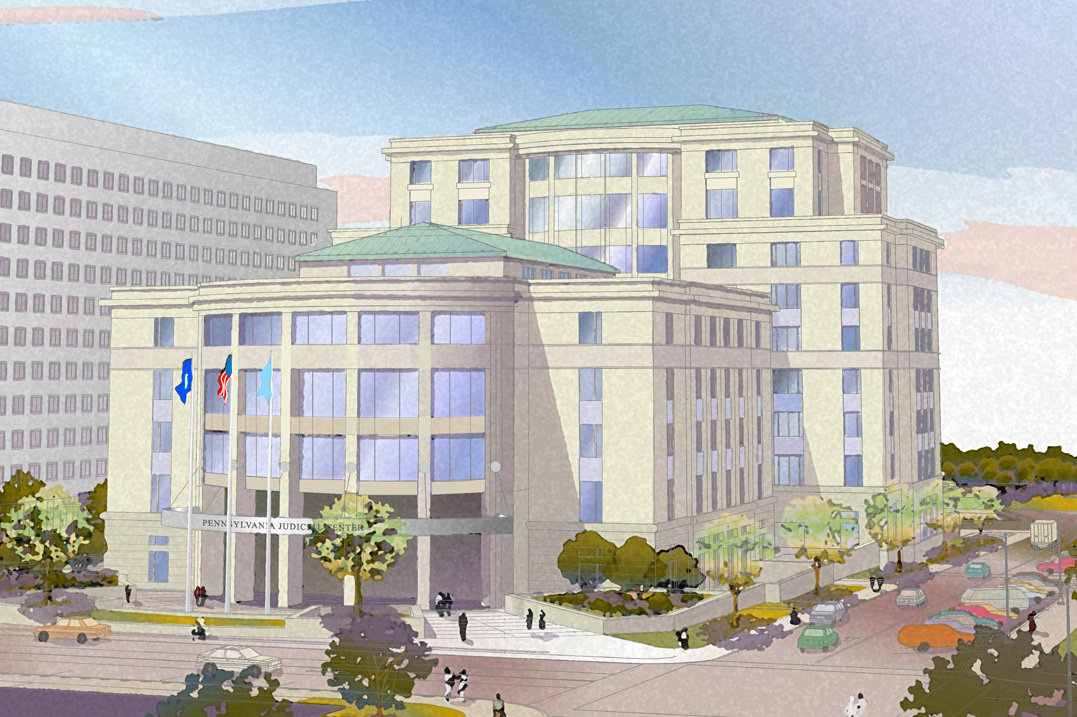Welcome to Brian M. Barna's AE Senior Thesis e-Portfolio
Building Statistics
Download Building Statistics Part 1 (pdf)
Download Building Statistics Part 2 (pdf)
| Building Name : | Pennsylvania Judicial Center |
| Location: | Harrisburg, PA (downtown government area) |
| Building Occupant Name: | Pennsylvania Unified Judicial System |
| Occupancy Type: | Courtrooms and offices |
| Size: | 425,000 sq. ft. |
| Number of Stories: | Nine |
| Project Team: | |
| Owner: | Pennsylvania Government |
| Architecture: | Vitetta |
| *Diversified Design provided initial architectural program | |
| Engineering: | Vitetta |
| Construction Mgmt.: | Heery International |
| Construction Dates: | Fall 2006 - Fall 2008 |
| Total Project Cost: | $90-95 million |
Architecture: This structure is a modern yet conservative building suitable for its judicial purpose. The building consists of three primarily rectangular forms. A centralized 5-story atrium topped with a skylight for major circulation and shared conference spaces is the main architectural pronouncement. There is also a 5-story mass that houses the Commonwealth Courts (courtrooms, judge’s chambers, related support spaces) and a 9-story office tower.
Major National Codes Used:
| Overall: | IBC 2003 and associated International Codes |
| Electrical: | National Electrical Code 2002 |
| Fire Protection: | National Electrical Code 2002 |
| Barrier Free: | ICC - ANSI A117.1 - 1998 |
| Accessibility: | ADAAG Title III (Americans with Disabilities Act) |
Zoning/Historical Requirements: Area must be used for a government building. The Judicial Center replaces the recently demolished Health and Welfare Parking Structure.
Building Envelope: The exterior of the building is primarily clad in Indiana limestone to match the other buildings in the Capitol Complex. The walls have parapets on all sides of a primarily flat roof. There are gable roofs on monitors that contain clerestory windows centered on the larger roof masses. There is also a large skylight that shines light upon the main atrium of the building.
System Descriptions:
Construction: The delivery method could be best described as design-bid-build with multiple prime contracts. Heery International was selected in April 2006 as the primary contractor. Demolition of an existing parking garage on the site was performed by Sabre Demolition Corp. Most of the foundation piers were unsuitable to support the building loads, but some of them could have been deemed adequate and preserved. The proximity of existing buildings and roads create a tight site which could require some creativity to manage. The project was bid out in August 2006, and bids were selected based on best value. This project is anticipated to be completed in late fall 2008.
Electrical: Power enters the building through two 12.47 kV service feeders. Each is converted to 480Y/277V through a 2500 kVA transformer. The 480Y/277V is supplied to the building through 2000A vertical bus ducts. The power is converted again to 208Y/120V power for receptacles. Backup power is available from a standby 1500 kW Diesel generator.
Lighting: Most of the lighting for this building runs on 277 V power. For the building interior, the standard light used was a 32W or 54W fluorescent, either four or eight feet in length, with 3500K color. Corridors, courtrooms, and elevator lobbies use wall sconces for aesthetic appeal. 3500K compact fluorescent luminous bowl pendants, with dimming capabilities, are featured inside courtrooms.
Mechanical: The HVAC system is a hot and chilled water variable volume air-handling unit system with fan-powered VAV boxes and capability of future humidity control. Ventilation air is supplied to indoor air-handling units from rooftop make-up air units with heat recovery wheels. The system includes variable volume hot and chilled water pumping: chilled water is generated through a heat exchanger from a central plant; hot water is generated through a heat exchanger from high pressure city steam (reduced in building). The system also includes a multiple-evaporator variable volume refrigerant system to cool security and data rooms throughout building.
Structural: The floor system is a composite system with lightweight concrete with a 6 ½” total slab thickness on 3” 18-gage composite cellular metal deck. The slab is supported by steel beams ranging from W16 to W30. The roof system is identical to the floor system, except that the framing is sloped to accommodate drainage of precipitation.
The structure is laterally supported by concentrically braced steel frames in both the N-S and E-W directions. This lateral system features no moment connections, and relies on concrete floor and roof slabs to act as rigid diaphragms and distribute the lateral loads accordingly.
The slab on grade will be fiber-reinforced with a typical minimum thickness of five inches. The concrete slab will rest on concrete piers with diameters that range from three to eight feet and depths that range from seven to fifteen feet. The piers will bear on rock with a bearing capacity of 40ksf. The concrete basement foundation walls will be supported by continuous wall footings.
Fire Protection: The building is designed as fully sprinklered, with flow switches and test valves in each sprinkler zone. The main fire pump is capable of supplying 1000 gpm (gallons per minute) with 150 head psi. The design minimums for sprinkler zones are 0.10 gpm/ft2 for offices and corridors, 0.15 gpm/ft2 for mechanical, file and storage rooms, and 0.20 gpm/ft2 for rooms designated as “Hazard Group 2.”
The structural frame (columns, girders, and trusses), floor construction, and bearing walls all meet a required two hour fire rating. The UL assemblies are X772 for the frame and D925 for the floor construction. The roof construction (UL Design P 725) has a fire rating of one hour.
Transportation: This building features seven elevators and six stairways, five of which have exterior egress.
Telecommunications: All of the modern technology features suitable for today’s courtrooms and offices are present. Teleconferencing, cable TV, internet access via fiber optic cables, and closed-circuit security cameras are some of the amenities present. Each courtroom features a full audio/visual desk for evidence presentation.
